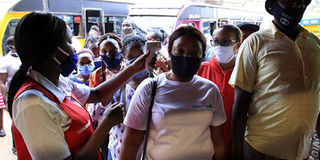Time to ease restrictions and open up economy amid safety measures

Quickmart Supermarket customers have their temperatures taken before they access the facility, in Nairobi on May 14, 2020. PHOTO | JEFF ANGOTE | NATION MEDIA GROUP
What you need to know:
- People everywhere in Kenya today have masks but few of them wear them in the right way. They only cover their mouth, leaving their noses exposed.
- But a prolonged disruption of national life will reduce us all to penury; we need to learn to live with the virus and safely reopen at least parts of the economy.
The worst thing to have in Kenya today is a temperature.
If you have a temperature of 37 degrees centigrade or higher, there are a number of things you can’t do.
You will not be admitted into supermarkets, you are excluded from most office buildings and, even if you are an essential worker, you can’t leave the lockdown zones.
And you can’t enter your beloved home county — if your governor knows what he or she is doing.
I took a reporting trip 250 kilometres from Nairobi, driving through the countryside under curfew, as a follow-up to our grand tour of the city after dark.
This time, rather than request security cover from the Directorate of Criminal Investigations, I thought it would be more authentic to go undercover.
Some of these concepts sound very clever when you are discussing them around a table but are unwise, and I’d not recommend them.
The roadblock at Blue Post Hotel on Thika Road is serious business. The General Service Unit are thorough.
I would not recommend that you joke around with them; they are not trained for that. Your temperature is taken by a paramedic who keeps social distance. You will not get past unless you need to and your paperwork is in order.
HANDWASHING
Traffic is light on the Nairobi-Nyeri road, the air clean and the countryside simply gorgeous. The roadside economy is devastated, of course.
Most of those kiosks selling delicious fruit and fruit tree seedlings have gone out of business. A few remain, but with little vibrancy.
Driving around without the annoying 14-seater matatus buzzing around like mosquitoes and smoky buses only a corner away from running you out of the road and into a ravine is a rare treat.
I wonder whether we can be rid of those in the post-Covid dispensation. Just after the Sagana bridge, all movement ceases.
Travellers are required to alight, wash their hands and have their details — particularly mobile phone numbers — taken.
I washed my hands with a razor-thin bar soap, knowing that soap, however lousy, is generally lethal to the virus.
After the Thuci bridge, the boundary between Embu and Tharaka-Nithi counties, something remarkable is happening. You park, alight, sanitise and you go through a spray booth, where you are disinfected from head to toe.
It is manned by generally serious paramedics. After I had my temperature taken, went through disinfection and gave my information, I hung around talking to someone who was taking photos for me. I was ordered to have my temperature taken a second time — and disinfected again.
FACE MASKS
Mwea is a hive of activity with thousands of rice farmers weighing, portioning, drying, hulling and otherwise doing a brisk, rice business.
People everywhere in Kenya today have masks but few of them wear them in the right way. They only cover their mouth, leaving their noses exposed.
When curfew hour strikes, the country empties. Mwea town, which never sleeps and rice is sold throughout the night, is deserted at 7.30pm.
In Embu, the last people on the road, rushing home, are supermarket workers. Just like in Nairobi, the curfew is holding in the countryside I visited.
The villages are dark and quiet. The small towns are deserted; you will probably see a motorcycle rider goofing around a little bit but he will be a solitary figure trying to demonstrate his courage by breaking the rules.
Night traffic is light, consisting of trucks and pick-ups ferrying essential supplies to the city. The distribution system appears unaffected. Rain appears plentiful and there seems to be lots of food.
I counted 11 roadblocks. By then I was feeling like a canoe that had run 11 rapids and fallen down waterfalls. If it’s not your job, stay at home; it’s dangerous and not worth it.
I have three main observations about the measures being taken to contain the virus.
REBELLION
First, there is a lot of police brutality but we are learning to obey movement restrictions, and the authorities are getting better at enforcing them without violence or corruption.
I heard the case of a man who was caught outside his home at 7pm, arrested and taken to the police station, where he was beaten so badly that when he was released the following day he could not leave as he couldn’t walk.
The risk of large-scale rebellion against restrictions is receding. And to contain community transmission, there does not seem to be an alternative to certain, probably geographically defined, restrictions.
But a prolonged disruption of national life will reduce us all to penury; we need to learn to live with the virus and safely reopen at least parts of the economy.
The monitoring stations on inter-county roads should all be converted into fumigation and rapid testing centres: vehicles and passengers fumigated and everyone tested before they go through.
Obtaining rapid testing kits is a tall order but not impossible in the near future. Or it could be made a requirement that, before essential workers are allowed out of lockdown areas, they must have taken a test in the previous 24 hours.
I am deeply concerned by the quickening spread of the virus — as seen from the mounting numbers — but I am also encouraged by the control mechanism, which I think can be ramped up to help in taming that awful bug.





